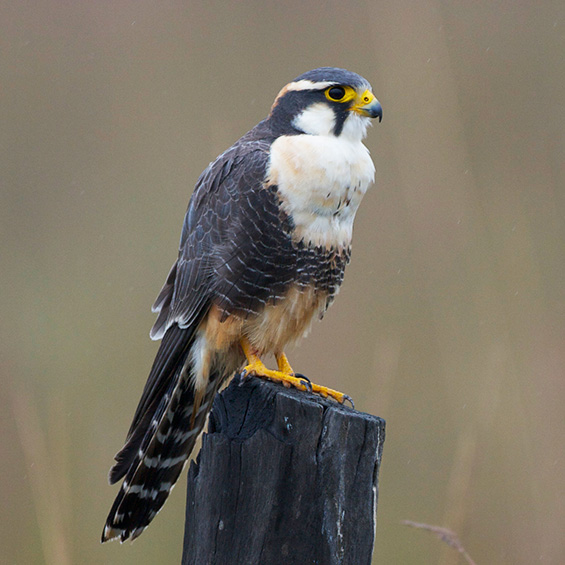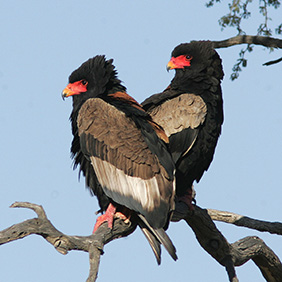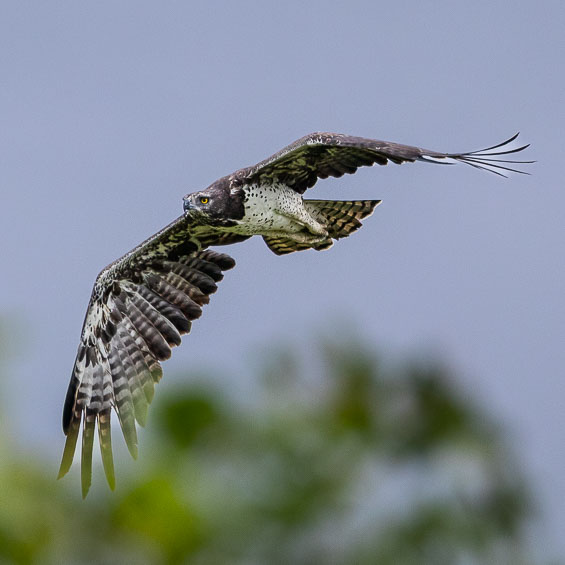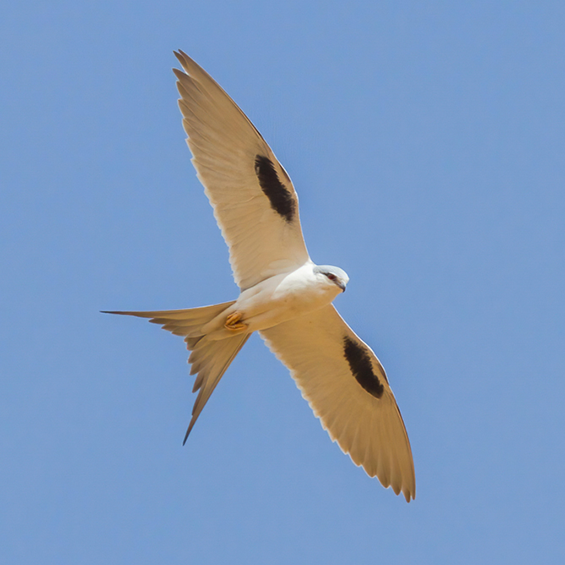2024 Senegal Tour Report
Senegal Raptor Tour Report 2024
by Yeray Seminario
Introduction
Our second Raptours to Senegal took us across a variety of landscapes, from the beaches of Mbour to the mangroves of the Saloum Delta, and from the savannas around Kedougou to the wetlands of Djoudj National Park. Our goal was to observe and document as many raptors and other bird species as possible while appreciating Senegal's natural beauty.
Our small group of birders was guided by experienced ornithologist Carlos Abdou and additional local guides. We explored diverse habitats, each offering different birding opportunities, from coastal areas with seabirds to inland savannah forests. Some of the observations included rare and endangered species like the Atlantic Humpback Dolphin and the Pel's Fishing-Owl, as well as 32 species of raptors. This report highlights our observations, showcasing Senegal's avian diversity.
WE ARE GOING BACK! EXPLORE OUR 2026 EDITION OF THIS EXCITING TOUR TO SENEGAL
Day 1 - Sunday, March 3 - Arrivals
Everyone arrived safe and sound in Dakar, and transferred to our hotel. We held a welcome briefing before dinner, and after a lively chat while eating delicious fish with local rice by the beach, we went to rest, ready to start the tour.
Day 2 - Monday, March 4 - Kaolack and Kousmar Forest
As soon as we got up from our hotel in Mbour, we began birdwatching on the beach. Here, we could see a wide variety of seabirds, including the amazingly close European Storm-Petrels, Parasitic Jaeger, Slender-billed and Gray-hooded Gull, and the West African Crested Tern. The first raptor of the tour? An Osprey!

Then, we headed towards Kaolack, making frequent stops along the road. During these stops, we observed many birds, including our first vultures, such as Hooded Vulture, White-backed Vulture, and Rüppell's Griffon. We also had a really fast, Red-necked Falcon and had the pleasure of observing dozens of Yellow-billed Kites and Black-winged Kites. A pair of Gray Kestrels were observed while hunting. Other birds of interest were the Black Scrub-Robin. At a short stop in the Fatick salt pans, we had our first Western Marsh Harrier, along with the common Abyssinian Roller and the dwindling European Turtle-Dove.
After our lunch in Kaolack, we headed to Kousmar Forest in search of the Savile's Bustard, which we were able to observe very well despite the heat. But before finding the bustard, we had not one, but three Verreaux’s Eagle-Owls! In the late afternoon, we approached Kousmar Island to observe the roosting of the Scissor-tailed Kites. We had great views of the kites, vocalizing and interacting. We were struck by the high number of Lesser Kestrels flying alongside them. It was a fantastic day to start our Raptor Tour!
Day 3 - Tuesday, March 5 - Saloum Delta, Sipo Is., Sandicoly
After a good rest and breakfast in Toubacouta, we took the boat from the pier of our hotel to explore the mangroves of the Saloum Delta. But just before we got to our boat, we spotted two dolphins navigating north, very close to the mangroves. Upon closer inspection of the pictures, we could confirm that they were indeed Atlantic Humpback Dolphins! This is a critically endangered species with a global population estimated below 3000 individuals. Once on the boat, it didn't take us long to spot the Mouse-brown Sunbird—we had superb views of two individuals. It took us a bit longer to spot the White-crested Tiger-Heron, but we finally managed to get a good view of two. This is a shy heron which can be quite difficult to see anywhere! Additionally, there was a wide variety of shorebirds present, and to everyone’s excitement, one adult Beaudouin’s Snake Eagle flying overhead, albeit a bit distant. We came out off the boat on Sipo Island. Here we saw quite a few sunbirds, both Pygmy and Beautiful, and had a great observation of two Palm-nut Vultures.

We took a well-deserved rest after lunch, and headed in the afternoon for the Sandicoly area. Once again, we saw a large number of birds in a very short time, including spectacular moments with raptors. We had a Gabar Goshawk perched very close to our vehicle for the longest time—in fact, we left the birds perched on the same spot we found it! An African Harrier-Hawk gave a good show and perched near us too, and we had great scope views of a Banded Snake Eagle, which is not commonly found in this area! Additionally, we observed Black Kites, and a Shikra. Other interesting birds such as the White-throated Bee-eater, Fanti Sawing and the Four-banded Sandgrouse.
Day 4 - Wednesday, March 6 - Sangako Forest, Saloum Delta
We began the morning searching for the Grayish Eagle-Owl from the hotel, but without success. After breakfast, we explored the Sangako forest. It was an excellent morning with sightings of over 60 bird species. We started with impressive raptors including a Wahlberg's Eagle, Lizard Buzzard, and Hooded Vulture.Among the interesting species spotted were the Bearded Barbet, Blue-spotted Wood-Dove, African Golden Oriole, and up to three Pearl-spotted Owlets. Towards the end of the morning, we were treated to the sight of a Grasshopper Buzzard, affording excellent views through our scopes before taking off, displaying its characteristic rusty underwing. Near the buzzard, we had fantastic views of the charismatic Temminck’s Courser, a pair with a chick running alongside. On our way back to the hotel, we enjoyed great views of an immature Beaudouin's Snake Eagle, quite distinct from the adult we had seen the day before.

After a break for lunch, we embarked on our second boat trip in the Saloum Delta in the afternoon. It was a delightful ride, with sightings of Ospreys (one of them with a German band), an African Harrier-Hawk,another Beaudouin’s Snake Eagle, a Western Marsh Harrier, and additions to our list such as the Swallow-tailed Bee-eater. We also marveled at the spectacular roost of herons and egrets at Bird Island, where Pink-backed Pelicans and African Darters were also present. In the evening, we made another attempt to find the owl, but once again, we were unsuccessful.
Day 5 - Thursday, March 7 - Toubacouta, road to Kaolack
This was our final opportunity to see the Grayish Eagle-Owl. Just when it seemed like we would return to the hotel empty-handed, while shining our torch on a Marsh Mongoose, we heard the unmistakable call of the owl. We approached, and to our surprise, with the sunrise imminent, the owl took flight and landed in front of us, giving us a truly special moment. It was incredible! After breakfast, we explored the surroundings of Toubacouta, adding more species to our list, such as the striking White Helmetshrike, the elegant Northern Puffback, and the delicate Lavender Waxbill. At another productive stop, we were fortunate to see the very special Black Scimitarbill, a species with a wide range but never common.
Leaving Toubacouta and the Delta du Saloum (what a great place), we headed to Kaolack, making occasional stops to see the Verb Trees, and spotting Palm-nut Vultures and Shikras along the way. Once in Kaolack, we prepared to rest for our long drive to Wassadou, our next destination.
Day 6 - Friday, March 8 - Kaolack, Fort de Maka Yop Ouest, road to Wassadou, River Gambia
Today was initially meant to be a driving day, but despite spending a considerable amount of time on the road, it turned out to be an exceptionally good birding day. After leaving Kaolack, we made a couple of stops, where we encountered some new bird species for us, such as the Black-crowned Tchagra and Northern Crombec. Along the road, we were delighted to spot a Dark Chanting-Goshawk, which we could observe at our leisure through the scope, followed shortly after by a soaring Wahlberg’s Eagle.
Later, at the Fort de Maka Yop Ouest, we ventured in search of the elusive Bronze-winged Courser. It didn’t take long until we found two of them! After enjoying lunch in Tambacounda, we continued our journey to Wassadou camp, arriving late in the afternoon. Our plan was to take it easy and scan the River Gambia from the camp, which always yields great sightings. However, our local guide, Carlos, received an exciting call from the boat skipper, informing him that he had spotted a Pel's Fishing-Owl and was coming for us!
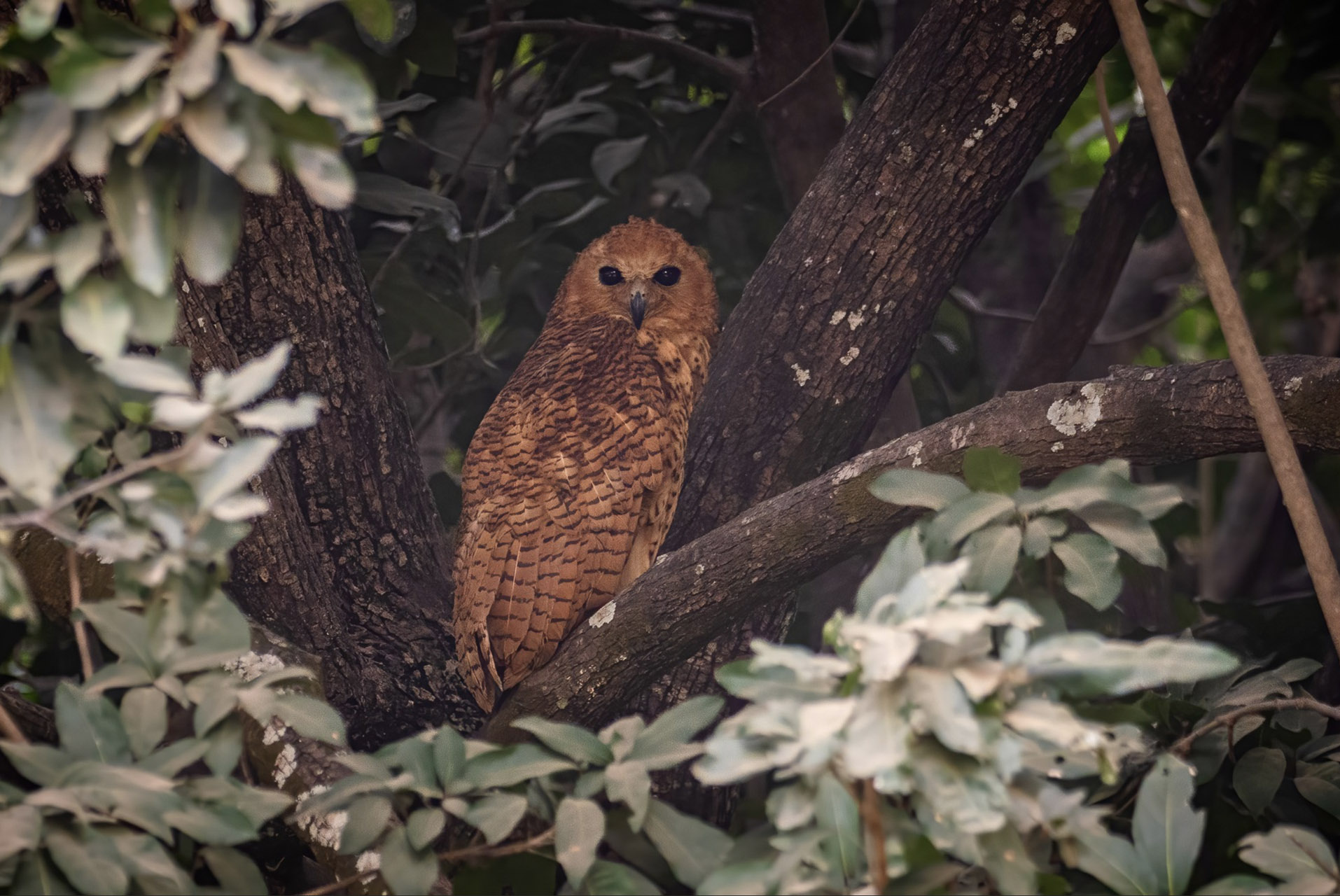
Excitedly, we got ready and boarded the boat as soon as it arrived at the small pier by the hotel. Despite the low water levels, the boat took us directly to where the skipper had found the owl. And there it was! After a few tense seconds ensuring everyone in the group had a view, and fearing it might fly off, we had the incredible opportunity to observe this magnificent and elusive owl. Moreover, we had a good view of a White-backed Night-Heron on our way back to the camp. It was a fantastic start to our stay in Wassadou.
Day 7 - Saturday, March 9 - Wassadou
We began before dawn with a bit of owling, but aside from a distant Long-tailed Nightjar and a Pearl-spotted Owlet, we didn’t encounter anything of interest. After breakfast, we embarked on one of our scheduled boat trips. Again, the water levels on the river were low, but boat trips here consistently yield fruitful sightings. We were greeted with a loud yawn by the Hippos and began our journey up the river, stopping to observe and photograph several species of Kingfisher: Malachite, Blue-breasted, Giant, and Pied were all spotted in the morning. The raptor sightings were also noteworthy! We enjoyed excellent views of the African Fish-Eagle, a flying Shikra, and a soaring Brown Snake Eagle—a new species for the tour. On our return to the hotel, we had the pleasure of encountering a very close African Finfoot.

Following the boat trip, we took a walk along the riverbank, which turned out to be excellent: an Osprey flew over the river, a couple of African Harrier-Hawks made appearances at different times, two more Brown Snake Eagles were spotted soaring, a Banded Snake Eagle was seen carrying a snake, two Wahlberg’s Eagles, a Lizard Buzzard, a flashing Shikra, and taking a bath in the river, two African Hawk-Eagles were observed! To add to our list of raptors on this walk, we also spotted a Yellow-billed Kite and another African Fish-Eagle. The non-raptor sightings were equally impressive, but perhaps the most notable were the sought-after Egyptian Plover, an incredibly handsome bird and a West Africa specialty, of which we saw two individuals flying around the riverside, being chased away by a snarky Wattled Lapwing, and sharing the space with an African Pied Wagtail.
We took a break after lunch to avoid the hottest part of the day, reconvening at a viewpoint overlooking the river to scan for raptors and other birds. Later, we embarked on another boat ride, during which we enjoyed great views of an African Woolly-necked Stork and a Palm-nut Vulture. Equally impressive were a couple of Yellow-winged Bats, with their striking bright-colored wings and ears, flying alongside the boat. After dinner, we made another attempt at owl-spotting, which proved to be more successful this time, although we had to work hard to catch sight of an elusive African Scops-Owl!
Day 8 - Sunday, March 10 - Wassadou, Kedougou, Bandafassi
Today marked our final morning at Wassadou camp, and we set out driving south to reach Kedougou in time for lunch. Along the journey, we made several stops whenever opportunities arose to spot raptors or new bird species. This approach rewarded us with sightings of two Black-winged Kites and several Abyssinian Ground-Hornbills, which were particularly impressive as we could distinguish between adult males, females, and juveniles. Further along the road, we were thrilled to spot our first Bateleur! An immature bird showcased its characteristic pendulating flight. We encountered two more later, followed by an adult male, distinguished by its prominent white forewing and black secondaries. What a spectacular sight! Our raptor sightings continued with another Banded Snake Eagle. As we drew closer to Kedougou, a deviation in the road led to a fortunate sighting of small birds near our vehicle. Among them were Chestnut-backed Sparrow-Larks, along with a Sun Lark—a new bird for some of us—and Sahel Bush Sparrows.

After a satisfying lunch and a rest at our comfortable hotel to escape the midday heat, we journeyed to the nearby site of Bandafassi. Our first stop was a water hole that proved to be highly entertaining. Hundreds of passerines congregated for drinking and bathing. Among the more common species, we spotted a Chestnut-crowned Sparrow-weaver, several Northern Red Bishops, and three Gosling’s Buntings. It was then that we noticed a Dark Chanting-Goshawk perched nearby, likely seeking its own refreshment.
Upon reaching the basaltic outcrops of Bandafassi, birding slowed down, but the sightings remained impressive. A fruiting tree attracted numerous Bruce’s Green-Pigeons, while a Violet Turaco flew off towards the cliffs we were heading to. As we approached the cliffs, we first encountered a few Neumann’s Starlings—a striking bird with a wide but patchy distribution in the Sahel and sub-Saharan regions. A Lanner Falcon with prey made a dramatic appearance, calling out as a second falcon joined it in mid-air exchange. The female falcon then carried the prey into a crevice—a remarkable sight! Among the rocks, we spotted small birds scurrying about, confirmed upon closer inspection as Stone Partridge. Our efforts paid off when Carlos spotted a single Fox Kestrel perched, fulfilling our quest for this particular small raptor! With a sense of accomplishment, we began our return to the van, not without spotting at least two African Scops-Owls, their calls echoing through the acacias nearby.
Day 9 - Monday, March 11 - Dindefelo
We set off in the morning for Dindefelo. There, we followed a trail through the forest towards a well-known waterfall. Although raptors were scarce, the area teemed with fascinating birdlife. Initially, we focused on obtaining clear views of both male and female Red-shouldered Cuckooshrikes. Soon after, we were delighted by the appearance of a Green-headed Sunbird, a new sighting for our group. The delicate Senegal Batis, another favorite among us, also made an appearance, allowing us to observe both males and females. Shortly thereafter, we encountered a recently discovered species for Senegal, the Willcox's Honeyguide! Continuing our trek, we delved deeper into the forest where we were treated to sightings of Narina Trogon and Guinea Turaco. While we enjoyed excellent views of the Trogon, it took some effort to catch glimpses of the Turaco. Upon reaching the waterfall, we were rewarded with breathtaking and refreshing views. Testing the water's chilliness by dipping our feet into the pool provided a welcome respite from the heat.
Returning to the village of Dindefelo after lunch and a break to avoid the hottest hours of the day, we embarked on another hike nearby which proved to be highly productive. Among the highlights were sightings of Dorst’s Cisticola, Orange-cheeked Waxbill, and the Mali Firefinch, a species restricted to Senegal and Mali!
Day 10 - Tuesday, March 12 - Kedougou, Basafatti, Gambia River
During our final morning in Kedougou, we took a short walk in a nearby acacia savannah. While the pace was slow, we were rewarded with another sighting of a Grasshopper Buzzard and discovered a Spotted Thick-knee, as well as a pair of Striped Kingfishers. Then, we returned to Basafatti, which proved to be a wise decision, as we were thrilled to encounter the Lanner couple once again. Additionally, we were fortunate to spot a Red-necked Buzzard, a new raptor sighting for us! We also observed numerous Black Kites migrating, two Beaudouin’s Snake Eagles, Bonelli's Eagles, Common Kestrels, and African Harrier-Hawks. The aerial displays of the Lanner Falcons continued to captivate us with their acrobatic flights. Later, at the water point, we encountered a significant number of raptors, particularly Hooded Vultures, along with more migrating Black Kites, two bathing Red-necked Falcons, and a Brown Snake Eagle.
After enjoying lunch at our hotel, we started our journey northward to Tambacounda, making another stop at a different section of the Gambia River. We took a stroll along the riverbank, immersing ourselves in the beauty of the wild riverine forest. Here, dozens of doves descended to drink, including the attractive Adamawa Turtle-Dove, along with European Turtle-Dove, Vinaceous Dove, Red-eyed Dove, Laughing Dove, and Black-billed Wood-Dove. Additionally, we were fortunate to spot a pair of White-crowned Lapwings nearby, and suddenly, we caught the brief call of the Northern Carmine Bee-eater. We were treated to the sight of more than thirty of these stunning birds, along with European Bee-eaters and Red-throated Bee-eaters. It was a fitting end to yet another rewarding day before the final leg of our journey.
Day 11 - Wednesday, March 13 - Tambacounda to Kaolack
We embarked on a long journey back to Kaolack from Tambacounda, setting off early to allow ample time for birdwatching stops along the way. During our first extended stop at a farming site, we were treated to a remarkable abundance of birds, notably a large flock of Sudan Golden Sparrows and Red-billed Queleas. The area was also bustling with other common yet plentiful species including Western Red-billed and African Gray Hornbills, African Gray Woodpeckers, and Rose-ringed Parakeets—making it an engaging stop.
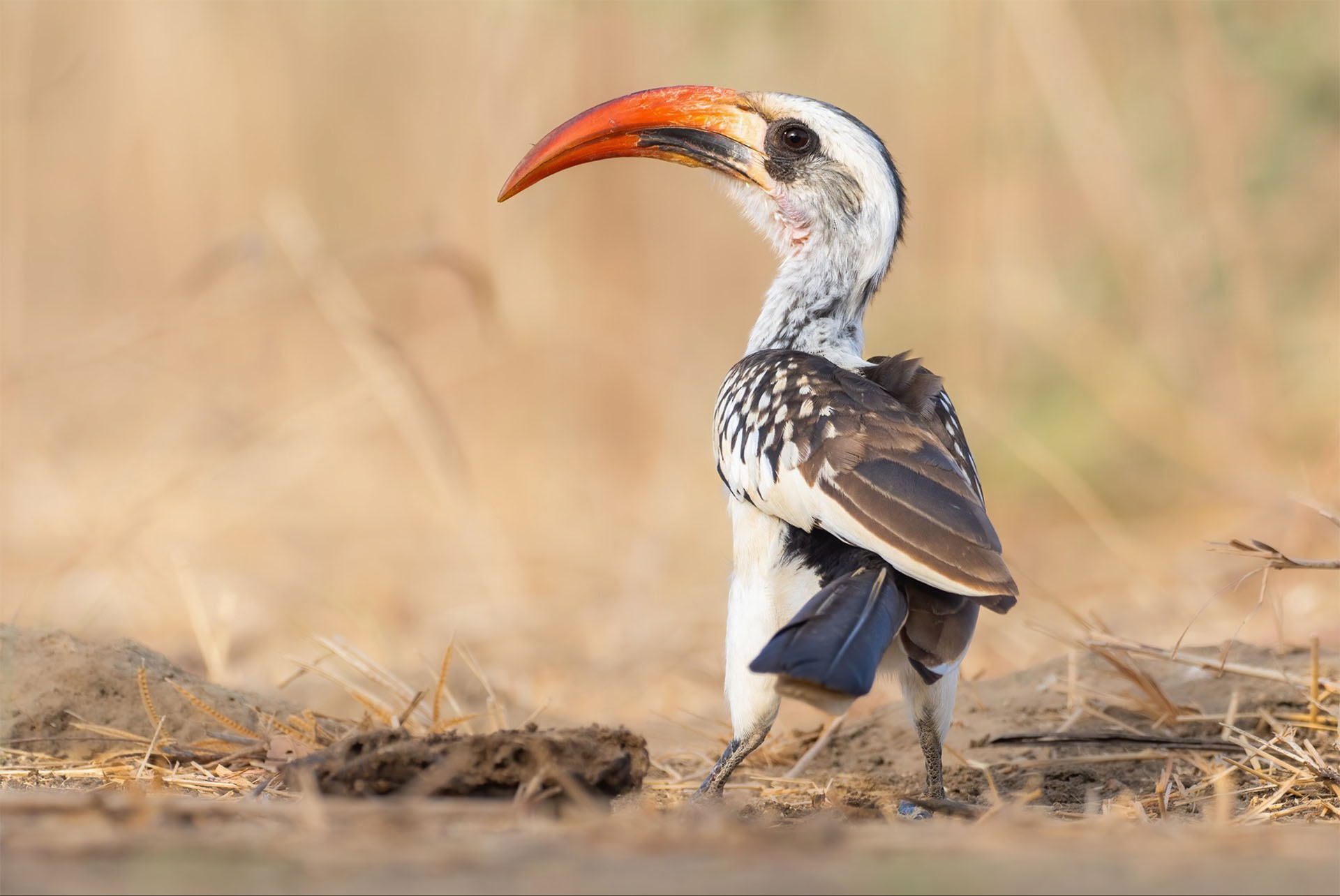
We then decided to make an effort to get a better view of the Bronze-winged Coursers, which we not only accomplished successfully, but also added a migrant Common Redstart to our list.
After a satisfying lunch in Kaolack, we had one final afternoon in the region, prompting us to explore an area near the town. We were initially greeted by sightings of some Greater Flamingoes, which later turned out to be several hundreds. While on the lookout for the charismatic Quailfinch, we spotted a harrier in the distance. As it approached, it became evident that it was a male Montagu’s Harrier— a pleasant surprise! Though our attempts to draw nearer to the harrier were unsuccessful, we were compensated by the discovery of a group of Quailfinches shortly afterward. Among the other notable birds observed in the afternoon were the stylish Rufous-tailed Scrub-Robin, a favorite among the group, and the African Green Bee-eater, the last species needed to complete our bee-eater list in Senegal.
Day 12 - Thursday, March 14 - Kaolack, Saint Louis, Les Trois Marigots
Today was another longish drive, but with some purposeful stops along the way. Our first stop on our northward journey was to seek out a particular bird, quite localized and rather elusive: the Quail-plover. Venturing into the open acacia savannah, we were greeted by a small flock of vultures soaring overhead. Among them were four White-backed, and three Rüppell’s Vultures, offering excellent views in flight. We could even distinguish between immature and adult plumages—a special sighting indeed. Additionally, we were treated to the sight of a Western Marsh Harrier exhibiting clear migration behavior. Surprisingly, it didn't take long before we spotted a couple of Quail-plovers. We proceeded cautiously, moving slowly to avoid startling them, and were rewarded with ample opportunity to observe them at our leisure. Our walk also afforded us sightings of a pair of Singing Bushlarks, Desert Cisticolas, and a Great Gray Shrike of the leucopygos subspecies.

Continuing our journey to Saint Louis, we made occasional stops whenever we spotted a special bird along the way. As we neared the outskirts of the city, we came across a water pond teeming with birdlife, particularly shorebirds such as Bar-tailed Godwits, Common Redshanks, Greenshanks, Curlew Sandpipers, Dunlins, Little Stints, and more.
Our final destination for the day was Les Trois Marigots, near Saint Louis, an excellent birding site where we encountered several highlights. These included up to three roosting Long-tailed Nightjars, beautiful African Swamphens and Black Crakes, and a Black Heron displaying its remarkable umbrella-like wing behavior to capture fish—a phenomenon known as “Canopy Feeding”. We put in considerable effort to catch a glimpse of the Greater Swamp Warbler, managing to hear and briefly see it. The River Prinia, on the other hand, made for an easier sighting as it sang from a prominent perch right in front of us. As the day drew to a close, we witnessed a magnificent sunset casting its reflection upon the waters of this truly special place, with hundreds of passerines heading to roost. We then made our way to a charming hotel in Saint Louis, where an exquisite French dinner awaited us!
Day 13 - Friday, March 15 - Djoudj National Park
We had a full day in Djoudj National Park, and we certainly made the most out of it! Along the drive to the gate, we added some good birds like Kittlitz’s Plover, Collared Pratincole, Winding Cisticola, and Yellow-crowned Bishop. Once at the gate of the National Park, we were welcomed by thousands of White-faced Whistling-Ducks along with a few Fulvous Whistling-Ducks, Northern Shovelers, Greater and Lesser Flamingos. On a small pond nearby, we had fantastic looks at the beautiful African Pygmy-Goose and a couple of Allen’s Gallinules.
We didn’t have much time to explore the surroundings, as we had to get to our boat to navigate the Marigot du Djoudj, just next to the border with Mauritania. This boat trip is usually very good, with impressive numbers of ducks and Great White Pelicans, which breed on small islands inside the marshes. It also provides good opportunities to see and photograph Ospreys, Western Marsh Harriers, and African Fish-Eagles. Other good birds here were African Spoonbill and Blue-cheeked Bee-eater. Moreover, on the way to the boat we had super close views of two African Golden Wolves!
We got out of the park and had lunch in a nearby camp. Here, we waited for temperatures to drop a bit and continued birding in the afternoon. It also provided a good chance to see new birds! We had good views of the Western Olivaceous Warbler, a single Iberian Chiffchaff that could be heard calling, and White-rumped Seedeaters.
The afternoon drive inside Djoudj was good too, allowing us to see a good number of Chestnut-bellied Sandgrouse, Black Crowned-Cranes, two Cream-colored Coursers, Blue-naped Mousebirds, two Black-crowned Sparrow-Larks, and good numbers of Zebra Waxbills. On the raptor front, we had a few Western Marsh Harriers and a beautiful male Montagu’s Harrier. At our last stop at the Grand Lac of Djoudj, we saw impressive numbers of ducks and shorebirds, including many Marsh Sandpipers that were new for the trip.
Day 14 - Saturday, March 16 - Road to Dakar
Our last day of the trip was mostly dedicated to driving south to Dakar, where we all had evening flights back home. However, it provided good opportunities for some final birding along the way. We had excellent views of a Savile’s Bustard right next to the road—the best views of the trip!—and we also spotted one of the main raptors we were missing, the impressive Lappet-faced Vulture. In fact, we saw up to three Lappet-faced Vultures together with a good number of other vultures, mainly White-backed, and Rüppell’s Vultures.
Our last birding spot was on the coast, where we added the Northern Gannet to the trip checklist. Before heading to the airport, we had a comfort stop at a nearby hotel to refresh and change clothes, which was a welcome respite before our long flight home.
Our second Raptours to Senegal was undoubtedly a success. Once again, we were fortunate to have a group of enthusiastic participants who embraced everything the country had to offer and enjoyed it immensely. We had excellent views of most raptors on our list and compiled a great list of birds and mammals. Senegal has proven to be a premier destination in West Africa for birders, nature enthusiasts, and especially raptorphiles!
Check out the Raptours Senegal 2024 - eBird Trip Report





























































